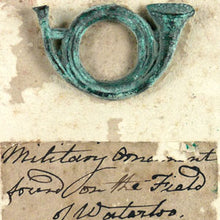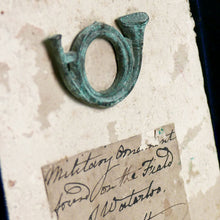Waterloo Relic - Cotton Museum Light Infantry Bugle Horn Badge, 1815
Adding product to your cart
Overall: 17.5cm (6.9in) x 18cm (7.1in)
Pressed brass. Napoleonic era light infantry hunting horn badge, possibly from Voltigeur officer’s belt clasp. Mounted on a 19th century card backing bearing manuscript inscription ‘… from Sergeant Cotton, late of / - sars- when visiting the Field / - 1847. T.M.S.’, additionally applied with a paper label bearing manuscript notation ‘Military ornament / found on the Field / of Waterloo. / Is 8d. / E. Cotton’. Badge: 28mm x 46mm.
The present relic was evidently purchased from the museum created by Sergeant-Major Edward Cotton (1792-1849), late 7th Hussars, who was a renowned Peninsula War and Waterloo veteran and an authority on the epic battle of 1815. After Cotton’s discharge from the Army in 1828, he settled at Mont St. Jean village on the Waterloo battlefield and soon established a reputation as a fine battlefield guide for the steady stream of tourists. He also built up a formidable knowledge of the battle from the many fellow Waterloo veterans who visited the site and published their recollections in 'A Voice from Waterloo'. His extensive collection of relics and memorabilia occupied a building at the base of the Lion Mound (built on the battlefield to commemorate the victory) became a must-see destination, with a pair of Napoleon’s silver spurs as one of its prized exhibits. The museum continued to be run after Cotton’s death until by his great-niece until its final dispersal in 1875.










